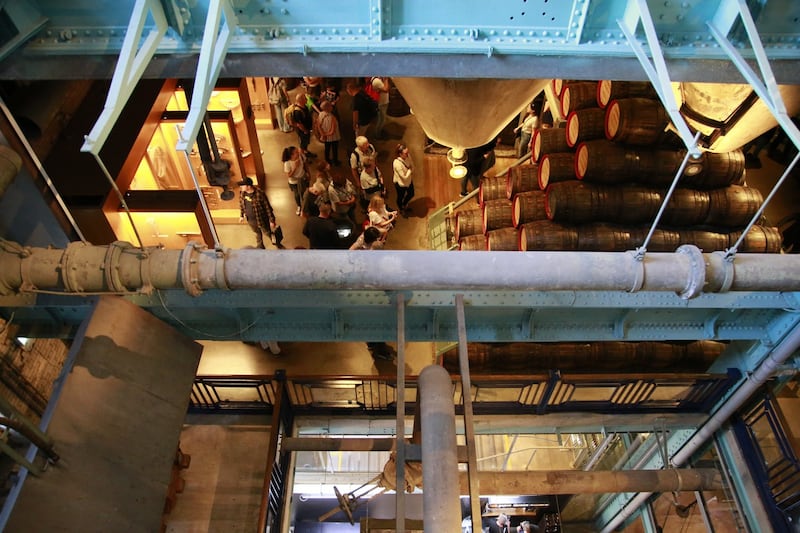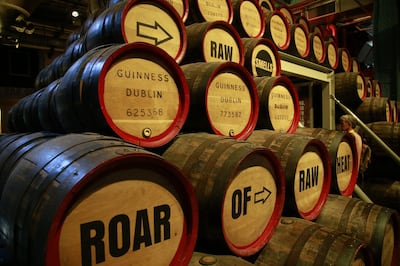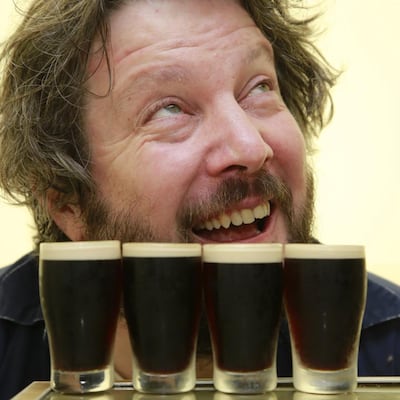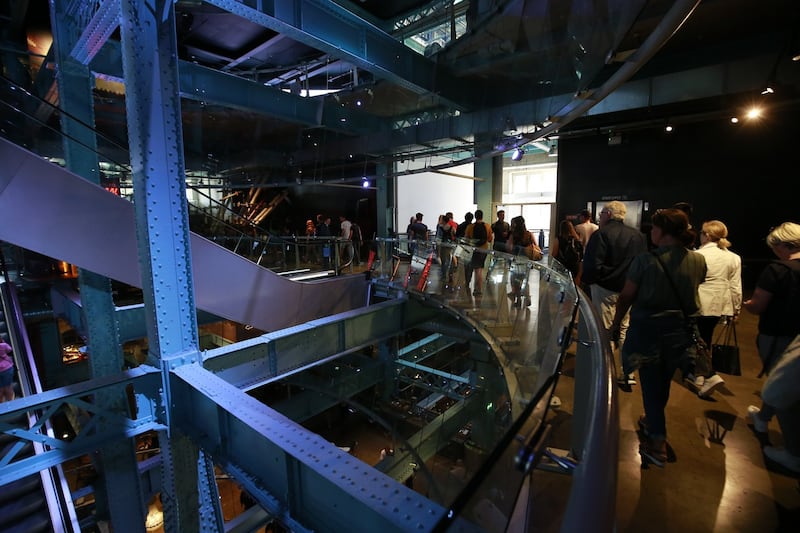Around 5,000 people visit the Guinness Storehouse every day. The Storehouse opened in 2000, as a way of delivering Guinness-related facts and branding to the masses. This year 1.7 million people will visit, 93 per cent of them international tourists.
Inside, the Guinness Storehouse is a blizzard of glass and steel and advertising kitsch, heavy on audiovisual technology and oversized props. The central atrium is seven storeys high and is shaped, my very entertaining and knowledgeable tour guide Leo Nally tells me, like a pint of Guinness, with the rooftop Gravity Bar representing the head.
"How many pints of Guinness would the atrium hold?" he asks.

The answer, which he provides, is 14.3 million pints. And over the course of the day I hear many more facts and figures. This boiling kettle takes 172,800 pints. That fermentation tank could fit eight double-decker buses. The leasing agreement Arthur Guinness signed on the September 31st, 1759 was for 9,000 years (seriously). A replica of this verbose document can be found beneath glass as we start the tour. The real thing is kept secure in the archives, and the last people to see it include the Queen and Tom Cruise.
27% of the people who come to the Storehouse have never tasted Guinness before yet have somehow been drawn here by the magnetic force of Diageo's branding
My tour group does not include the Queen or Tom Cruise. There’s Kie, a young Japanese woman who lives in York. She is marking her birthday with a cheap flight to Dublin. There’s Devon Thornton who works in the wine trade, and has spent the past week touring the wineries of Italy with her partner Richard Quinn. And there’s Brette Harris and Graeme Nordell, graduate students from Edmonton in Canada. They are here, Brette says, “because this is the first thing that comes up when you look at what to do in Dublin”.
Graeme is also a bit of a beer aficionado. “Me and a couple of buddies make home brews, but we’re amateurs.”
“You should get a 9,000-year-lease,” I say.
“But then you’re locked in for 9,000 years,” he says, wisely.
Bizarrely, 27 per cent of the people who come here have never tasted Guinness before, and yet have somehow been drawn here by the magnetic force of Diageo’s branding. “Someone asked me a few weeks ago if Guinness was the same as an Irish coffee,” says Leo.

Leo walks us around some exhibits on the second floor representing the various ingredients. These include some yeast in a safe, a waterfall representing water from the Wicklow mountains (90 years ago some visiting scientists figured out that this magnesium-sulphate rich water was very important to Guinness’s success as a drink) and a big pile of barley. Roasted barley gives Guinness its colour. “What colour is Guinness?” Leo asks. “You’re an Irishman, Patrick, what do you think?”
I am an Irishman but, like the people of Guinness, I work for an institution with a complicated Anglo-Irish legacy, so I get this wrong. “Black,” I say.
The answer is “ruby red”. Guinness has been marketing itself as “the black stuff” for ages, says Leo. “It’s all a lie.”
We come to a painting of Arthur Guinness and Leo recounts the man’s life story from his origins in Co Kildare, to his beginnings as a brewer in Leixlip, to the opening of his second brewery at St James’s Gate. Initially Arthur made red ale, but after a visit to London he discovered porter (so called, apparently, because it was beloved by porters) which developed into a “stouter” kind of porter that ultimately became known as “stout”. Later, Graeme asks about other Irish stouts and I get Leo to put his fingers in his ears while I tell him about Beamish and Murphys.
Leo tests us occasionally. “Almost 30 per cent of all Guinness sales are in March,” he says, after explaining the brewing process on front of some boiling kettles. “Why is that?”
“Patrick’s Day?” says Devon Thornton.
“Yes,” says Leo.
“Yeah, on Patrick’s Day people go crazy for Guinness in Texas,” says Richard.

Graeme wants to know how the widget in the can of Guinness works, and Leo explains the science of how the widget releases nitrogen to create the creamy head. “We would always recommend you pour your Guinness into a glass first,” he says. “When you’re drinking wine you don’t drink from a Capri-Sun pouch.”
I tell him that it would be amazing if they released a Guinness product in a Capri-Sun pouch. He says that he’ll take my idea to management.
We pass a load of barrels. There were once 300 coopers employed here. “We had horses too. Clydesdale horses which you might know from another beer I can’t mention.”
“Budweiser,” says Richard.

In the transport section there are models of tankard ships and the last of the little trains that once drove around the facility. Nearby there's a 4m, two-tonne wooden sculpture created by 20 artists in 2012. It's one of Leo's favourite exhibits. It's shaped like a pint with Guinness-dyed Irish lace as the head. Its carved surface features maps of major Guinness markets, animals which have featured in major marketing campaigns, the mountains from where the water comes, and the 14th-century Brian Boru harp that Guinness has used as a trademark since 1862. (The harp used by the Irish State is the same harp. In order to avoid a trademark dispute, they reversed the image.)
“Are you thirsty?” Leo asks. We are definitely thirsty. He brings us down an eerie dark corridor which leads into a bright white room, where four waist-high pillars are emitting vapour, each with a distinct aroma associated with a Guinness ingredient. There’s a bar in the room and we’re given a tiny glass of Guinness, which we carry with us into a darker room. There, Leo teaches the foreigners how to say the word “sláinte” and how to best experience stout using “retro-nasal tasting”. We drink and he describes what we’re experiencing: “A malty sweetness at the front… Dark chocolate, coffee, roasted barley at the side. And at the back, that bitter-sweet finish.”
Do people have to drink Guinness if they work here? “Not at all. There are loads of coeliacs here. And I didn’t drink Guinness before I came here… So either I drank the Kool-Aid or this place works.” He laughs. “You’re walking around telling people how good Guinness is. At a certain point it gets in your head.”

He talks us through some of the Guinness family portraits lining the walls and tells us about the extended family. He mentions, among other things, the housing charity the Iveagh Trust (established by the Guinness family in the early 20th century), Guinness heir and friend of the Beatles Tara Brown, and his brother, the traditional music guru Garech Browne. Leo has given tours to actual Guinness family members. It's so strange, he says, when someone points at a portrait and says "And here's my great-great-grandfather".
Soon we're on the level that deals with advertising campaigns. It's filled with posters and figurines of the John Gilroy-designed animal mascots. Leo recites a few of the accompanying poems. "If you think Guinness is good for you. Imagine what toucan do."
“It’s still funny,” chuckles Graeme.
The company only started advertising in 1929. Prior to that, the chairman Edwin Guinness felt advertising was for losers (lord knows what he would have made of the Storehouse, a huge shrine and advertisement in one). So the first-ever Guinness ad appeared in the Daily Mail two years after his death. It said, “Guinness builds strong muscles. It feeds exhausted nerves. It enriches the blood. Doctors affirm that Guinness is a valuable restorative after influenza and other weakening illnesses. Guinness is a valuable natural aid in cases of insomnia.”
'Guinness is good for you' is no longer the company line. It's in no way 'good for you', confirms the guide
“Eight or nine pints of Guinness might help with insomnia,” says Graeme charitably.
“Guinness is good for you” is no longer the company line. “It’s in no way ‘good for you’,” confirms Leo.
In this section there are also pub clocks declaring it to be “Guinness time”, a fish on a bicycle evoking the Irina Dunn quote, “A woman needs a man like a fish needs a bicycle”, and a whistling oyster used to advertise Guinness in North America. There are also a few of the 150,000 tiny bottles containing a Guinness endorsement from King Neptune that were dropped into the sea to celebrate the company’s bicentenary in 1959. These still wash up on the beach occasionally, Leo tells us, which technically make it the longest-running advertisement campaign of all time.

We are then brought to a bar where Leo teaches us to pour the perfect pint and then gives us a certificate. “Everyone gets one. I mean everyone,” says Leo. “Sometimes more Guinness ends up on the floor than in the glass.”
We pour our pints and then have our photos taken only to have those photos printed on the head with a special new printing process called “Stoutie”. None of us are quite sure how to feel about drinking our own faces. “Would you call it getting ‘sh** faced’?” asks Graeme. Later, as we drink our pints in the Gravity Bar overlooking the city, someone likens our half-consumed pint-faces to those “pictures of Jesus that turn up on toast”.
At this stage, my tour-mates are quite impressed. “There’s so much history in a brewery like this,” says Brette. She laughs. “I mean, Guinness is older than Canada.”
History is the saving grace of the Storehouse, which otherwise might look like a kitsch over-the-top tourist-industry land-grab by a now British-domiciled company
This real weight of history is ultimately the saving grace of the Storehouse, which otherwise might look like a kitsch over-the-top tourist-industry land-grab by a now British-domiciled company (Diageo). So after a very good meal at the Brewers’ Dining Hall restaurant, including some oysters with a recommended Guinness (“I’m guessing Guinness is the recommended drink for everything,” says Graeme), one of the archivists, Jessica Handy, brings us down to show us some treasures from the archive.
This isn’t normally part of the tour, but it’s fascinating. She shows us an original John Gilroy sketch of a pint-glass-swallowing ostrich. “When it came out it prompted a flood of letters,” she says. “They wanted to know, ‘Why is the glass this way up in the ostrich’s neck because surely, if he had drunk it, it would be the other way around?’… It does beg the question what people in 1939 were doing that they had time to write in about something like that… Now we’ve got these sketches, so we can look and see that Gilroy did play around with doing it the other way.”

She dons white gloves to page through a minute book of the Brewer’s Guild from the 1750s, to show Guinness’s craftsmanship being recognised by his colleagues. “They were very fond of embellishing signatures in those days. There are a lot of swirls.”
There are a lot of bottles, from all over the world and stretching back through the centuries, and there are a lot of old ledgers. She tells us that they have seven kilometres of shelving featuring Guinness-related items, and they now provide a genealogical service for the many people whose family members once worked for Guinness. They tracked down one old employee a few years ago for a video interview, Michael Ash, the man who developed draft Guinness in 1959. There was such scepticism about the draft Guinness project back in the 1950s, she tells us, that it was known internally as “Daft Guinness”.
She opens an old recipe book which details how on April 22nd, 1799, Guinness brewed its last batch of red ale. By then, she says, the company had moved exclusively into brewing porter, and she shows us a bottle of this from the early 1800s. There’s still liquid in it. “I don’t recommend anyone tries to drink from it,” she says. She must be reading my mind, because as I stand there, in this strange monument to beer, feeling drunk on Guinness facts and exactly one pint, I feel quite thirsty.


















